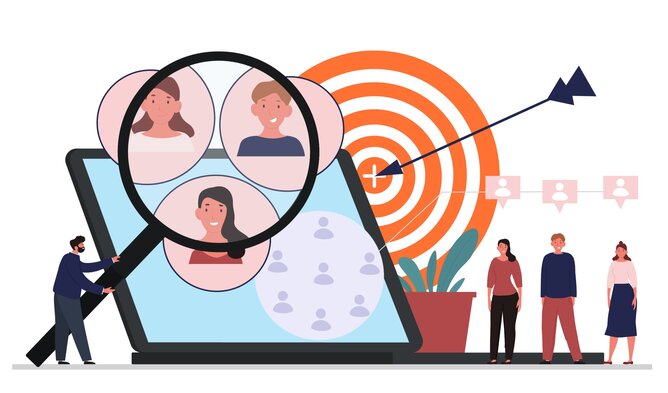Lack of engagement and customer loyalty will have a major impact on your manufacturing marketing efforts.
If your current strategy isn’t bringing back return buyers, you’re doing it all wrong and potentially throwing away hundreds of thousands of dollars.
In order to fix this and start bringing in more revenue, you need to get serious about identifying your target audience.
Let’s dive into what a target audience is, how to identify it, and the importance of understanding their needs, pain points, and motivations. We’ll also provide practical tips and advice on how to craft marketing messages that resonate with your target audience and mistakes to avoid.
What is a target audience?
A target audience is the specific group of people that your manufacturing company is trying to reach with its marketing messages. This group of people shares certain characteristics that make them more likely to be interested in your products or services, such as demographics, interests, behaviors, or needs. Identifying your target audience is the foundation of effective marketing, as it allows you to tailor your messages to the people who are most likely to be interested in what you have to offer.

Identifying your target audience makes your marketing more effective. By focusing your marketing efforts on the people who are most likely to be interested in your products or services, you’ll increase your chances of getting your message in front of the right people and driving engagement and sales. This, in turn, will help you save time and money by avoiding marketing to people who are unlikely to be interested in what you have to offer.
Nailing down your audience will also help you improve customer engagement and build stronger relationships with your customers. When you understand their needs, pain points, and motivations, you can create marketing messages that speak directly to them, addressing their concerns and offering solutions that are tailored to their specific needs. This will help you build trust and credibility with your customers, leading to increased loyalty and repeat business.
You will also be able to focus your marketing efforts on the people who are most likely to be interested in your products or services, making your marketing more effective and efficient. It also helps you build stronger relationships with your customers by understanding their needs and addressing their concerns in your marketing messages. In the next section, we’ll discuss how to identify your target audience and start reaping the benefits of targeted manufacturing marketing.
How to identify your target audience

Identifying your target audience requires a deep understanding of your products or services, as well as the pain points of the people who are most likely to be interested in them. Here are some steps you can take to identify your target audience:
Define your product or service
Start by defining your product or service and what sets it apart from the competition. Consider what problems and pains your product or service solves, what benefits it provides, and what makes it unique.
Conduct market research
Conduct market research to identify the people who are most likely to be interested in your product or service. This can include demographic research, such as age, gender, income, and education level, as well as psychographic research, including interests, values, and behaviors.
Analyze your existing customer base
Analyze your existing customer base to identify common characteristics among your most loyal and profitable customers. This can help you identify trends and patterns that can inform and guide your target audience research.
Create buyer personas
Use the information you’ve gathered to create buyer personas, which are fictional representations of your ideal customers. These personas should include demographic information, interests, behaviors, needs, pain points, and any other relevant information you see fit.
Refine your target audience
Refine your target audience by analyzing your buyer personas and identifying commonalities and differences. This can help you decipher the key characteristics that define your target audience and create more effective marketing messages.
Identifying your target audience is an ongoing process that requires constant monitoring and adjustment. As your business and market evolve, so should your target audience research.
By staying attuned to your target audience’s needs and preferences, you can create marketing messages that resonate with them and drive engagement and sales. In the next section, we’ll discuss the importance of understanding your target audience’s needs, pain points, and motivations, and how to use this information to create effective marketing messages.
Tailoring your marketing message
Once you have identified your target audience, the next step is to create marketing messages that speak directly to them. Here are some tips for tailoring your marketing messages to your target audience:
Understand your target audience’s needs
Start by understanding your target audience’s needs, pain points, and motivations. Use the buyer personas you created to identify the key issues and concerns that your target audience is likely to have, and consider how your product or service can address these needs.
Use the right tone and language
Use the right tone and language to speak to your target audience. Consider their age, education level, and cultural background, and use language and terminology that they will understand and relate to.
Highlight the benefits
Highlight the benefits of your product or service that are most relevant to your target audience. Show them how your product or service can solve their problems and improve their lives, and use examples and testimonials to provide social proof and build trust.
Use the right channels
Use the right channels to reach your target audience. Consider where they spend their time online and offline, and use channels that they are most likely to use. This could include social media, email marketing, direct mail, trade shows, and more.
Monitor and adjust
Finally, monitor and adjust your marketing messages based on your target audience’s response. Use analytics tools, like Google Analytics, to track engagement and conversion rates, and adjust your messages and channels as needed to improve your results.
Use social proof
Social proof can be a powerful tool in crafting your marketing message. Use customer testimonials, reviews, and case studies to show your target audience how others have benefited from your product or service.
Focus on emotions
Emotions can be a powerful motivator in marketing. Use emotional triggers that will resonate with your target audience, such as fear, excitement, or trust, to create messaging that speaks directly to them.
Use visuals
Visuals are such a powerful tool when it comes to creating effective marketing messages. Use high-quality images, videos, and graphics to craft a message that is visually appealing and engaging.
By tailoring your marketing messages to your target audience, you can increase engagement and conversion rates, build stronger relationships with your customers, and drive more sales and revenue for your manufacturing business.
Common mistakes to avoid
Identifying and targeting your audience is a powerful way to boost your marketing efforts–as long as you avoid the following mistakes:

Assuming everyone is your audience
One of the biggest mistakes manufacturers make is casting the net too broad and assuming that everyone is their audience. Increased traffic doesn’t matter if that traffic isn’t relevant.
It’s important to understand that not everyone will be interested in your product or service, and trying to appeal to everyone will dilute your message and make it less effective. Instead, focus on identifying a specific niche audience and tailor your marketing efforts accordingly.
Relying solely on demographic data
While demographic data can be useful for identifying your target audience, it’s important to remember that people are more than just their age, gender, and income level. It’s also important to consider psychographic data, such as values, interests, and behaviors, when identifying and targeting your audience.
Neglecting to refine your target audience
Once you’ve identified your target audience, it’s important to continue refining it over time. As your business and market evolve, so too should your target audience research. Neglecting to refine your target audience can result in outdated marketing messages that are less effective.
Failing to personalize your marketing messages
Personalization is key to effective marketing, and failing to personalize your marketing messages can make them feel generic and irrelevant to your target audience. Use your buyer personas to create personalized messages that speak directly to the needs and concerns of your target audience.
Ignoring feedback and analytics
Finally, ignoring feedback and analytics can lead to missed opportunities and ineffective marketing messages. Use analytics tools to discover where changes need to be made, and use feedback from your customers to improve your marketing messages and refine your target audience over time.
By avoiding these common mistakes, you can create more effective marketing messages, build stronger relationships with your customers, and drive more sales and revenue for your manufacturing business. Remember, identifying your target audience is not a one-time process. As your business evolves and your market changes, so too should your target audience research.
